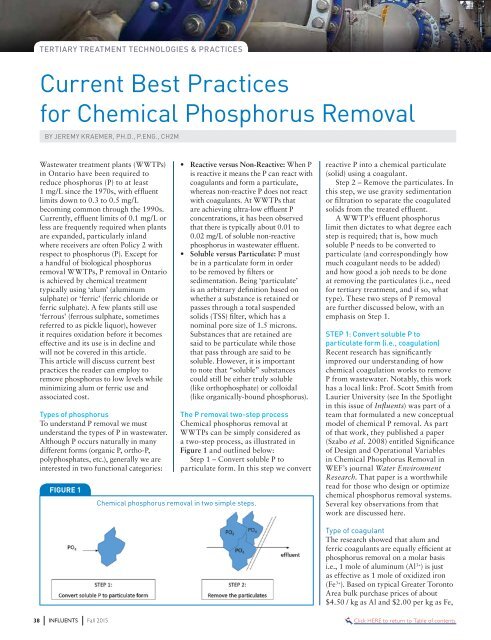lauren@kelman.ca
1YLWYxL
1YLWYxL
Create successful ePaper yourself
Turn your PDF publications into a flip-book with our unique Google optimized e-Paper software.
TERTIARY TREATMENT TECHNOLOGIES & PRACTICES<br />
Current Best Practices<br />
for Chemi<strong>ca</strong>l Phosphorus Removal<br />
BY JEREMY KRAEMER, PH.D., P.ENG., CH2M<br />
Wastewater treatment plants (WWTPs)<br />
in Ontario have been required to<br />
reduce phosphorus (P) to at least<br />
1 mg/L since the 1970s, with effluent<br />
limits down to 0.3 to 0.5 mg/L<br />
becoming common through the 1990s.<br />
Currently, effluent limits of 0.1 mg/L or<br />
less are frequently required when plants<br />
are expanded, particularly inland<br />
where receivers are often Policy 2 with<br />
respect to phosphorus (P). Except for<br />
a handful of biologi<strong>ca</strong>l phosphorus<br />
removal WWTPs, P removal in Ontario<br />
is achieved by chemi<strong>ca</strong>l treatment<br />
typi<strong>ca</strong>lly using ‘alum’ (aluminum<br />
sulphate) or ‘ferric’ (ferric chloride or<br />
ferric sulphate). A few plants still use<br />
‘ferrous’ (ferrous sulphate, sometimes<br />
referred to as pickle liquor), however<br />
it requires oxidation before it becomes<br />
effective and its use is in decline and<br />
will not be covered in this article.<br />
This article will discuss current best<br />
practices the reader <strong>ca</strong>n employ to<br />
remove phosphorus to low levels while<br />
minimizing alum or ferric use and<br />
associated cost.<br />
Types of phosphorus<br />
To understand P removal we must<br />
understand the types of P in wastewater.<br />
Although P occurs naturally in many<br />
different forms (organic P, ortho-P,<br />
polyphosphates, etc.), generally we are<br />
interested in two functional <strong>ca</strong>tegories:<br />
FIGURE 1<br />
• Reactive versus Non-Reactive: When P<br />
is reactive it means the P <strong>ca</strong>n react with<br />
coagulants and form a particulate,<br />
whereas non-reactive P does not react<br />
with coagulants. At WWTPs that<br />
are achieving ultra-low effluent P<br />
concentrations, it has been observed<br />
that there is typi<strong>ca</strong>lly about 0.01 to<br />
0.02 mg/L of soluble non-reactive<br />
phosphorus in wastewater effluent.<br />
• Soluble versus Particulate: P must<br />
be in a particulate form in order<br />
to be removed by filters or<br />
sedimentation. Being ‘particulate’<br />
is an arbitrary definition based on<br />
whether a substance is retained or<br />
passes through a total suspended<br />
solids (TSS) filter, which has a<br />
nominal pore size of 1.5 microns.<br />
Substances that are retained are<br />
said to be particulate while those<br />
that pass through are said to be<br />
soluble. However, it is important<br />
to note that “soluble” substances<br />
could still be either truly soluble<br />
(like orthophosphate) or colloidal<br />
(like organi<strong>ca</strong>lly-bound phosphorus).<br />
The P removal two-step process<br />
Chemi<strong>ca</strong>l phosphorus removal at<br />
WWTPs <strong>ca</strong>n be simply considered as<br />
a two-step process, as illustrated in<br />
Figure 1 and outlined below:<br />
Step 1 – Convert soluble P to<br />
particulate form. In this step we convert<br />
Chemi<strong>ca</strong>l phosphorus removal in two simple steps.<br />
reactive P into a chemi<strong>ca</strong>l particulate<br />
(solid) using a coagulant.<br />
Step 2 – Remove the particulates. In<br />
this step, we use gravity sedimentation<br />
or filtration to separate the coagulated<br />
solids from the treated effluent.<br />
A WWTP’s effluent phosphorus<br />
limit then dictates to what degree each<br />
step is required; that is, how much<br />
soluble P needs to be converted to<br />
particulate (and correspondingly how<br />
much coagulant needs to be added)<br />
and how good a job needs to be done<br />
at removing the particulates (i.e., need<br />
for tertiary treatment, and if so, what<br />
type). These two steps of P removal<br />
are further discussed below, with an<br />
emphasis on Step 1.<br />
STEP 1: Convert soluble P to<br />
particulate form (i.e., coagulation)<br />
Recent research has signifi<strong>ca</strong>ntly<br />
improved our understanding of how<br />
chemi<strong>ca</strong>l coagulation works to remove<br />
P from wastewater. Notably, this work<br />
has a lo<strong>ca</strong>l link: Prof. Scott Smith from<br />
Laurier University (see In the Spotlight<br />
in this issue of Influents) was part of a<br />
team that formulated a new conceptual<br />
model of chemi<strong>ca</strong>l P removal. As part<br />
of that work, they published a paper<br />
(Szabo et al. 2008) entitled Signifi<strong>ca</strong>nce<br />
of Design and Operational Variables<br />
in Chemi<strong>ca</strong>l Phosphorus Removal in<br />
WEF’s journal Water Environment<br />
Research. That paper is a worthwhile<br />
read for those who design or optimize<br />
chemi<strong>ca</strong>l phosphorus removal systems.<br />
Several key observations from that<br />
work are discussed here.<br />
Type of coagulant<br />
The research showed that alum and<br />
ferric coagulants are equally efficient at<br />
phosphorus removal on a molar basis<br />
i.e., 1 mole of aluminum (Al 3+ ) is just<br />
as effective as 1 mole of oxidized iron<br />
(Fe 3+ ). Based on typi<strong>ca</strong>l Greater Toronto<br />
Area bulk purchase prices of about<br />
$4.50 / kg as Al and $2.00 per kg as Fe,<br />
38 INFLUENTS Fall 2015<br />
Click HERE to return to Table of contents


